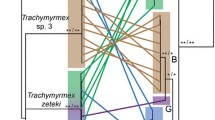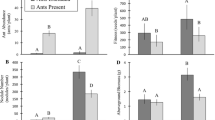Abstract
Interspecies or intraspecies cooperation can be stabilized evolutionarily if choosing partners favor beneficial partners and discriminate against non-beneficial partners. We quantified such partner choice (symbiont choice) in the leafcutter ant Atta texana (Attini, Formicidae) by presenting the ants in a cafeteria-style preference assay with genotypically distinct fungal cultivars from A. texana and Acromyrmex versicolor. Symbiont choice was measured as the ants' tendency to choose one or more cultivar(s) from several pure (axenic) cultivar fragments and convert a given fungal fragment into a garden. Microsatellite DNA fingerprinting enabled us to identify the cultivars chosen by the ants for their gardens. In 91% of the choice tests, A. texana workers combined multiple cultivars into a single intercropped, chimaeric garden, and the cultivars coexisted in such chimaeric gardens for as long as 4 months. Coexistence of distinct fungal genotypes in chimaeric gardens appears to contradict a recent model of cultivar competition postulating that each cultivar secretes incompatibility compounds harming other cultivars, which presumably would preclude the intercropped polyculture observed in our experiments. Although we found no clear evidence of novel, recombinant genotypes in the experimental chimaeric gardens, the intercropping of cultivar genotypes may occasionally lead under natural conditions to exchange of genetic material between coexisting cultivars, thus introducing novel cultivar genotypes into the leafcutter symbiosis. Symbiont choice by ants and any competition between coexisting cultivar strains in chimaeric gardens do not appear to operate fast enough in our laboratory assay to convert chimaeric gardens into the monocultures observed for A. texana under natural conditions.



Similar content being viewed by others

References
Adams RMM, Mueller UG, Holloway AK, Green AM, Narozniak J (2000) Garden sharing and garden stealing in fungus-growing ants. Naturwissenschaften 87:491–493
Advani NK, Mueller UG (2006) A preference assay for quantifying symbiont choice in fungus-growing ants (Attini: Formicidae). Insect Soc 53:446–455
Autuori M (1950) Contribuição para o conhecimento da saúva (Atta spp. Hymenoptera-Formicidae) V. Número de formas aladas e redução dos sauveiros iniciais. Arq Inst Biol Sao Paulo 19:325–331
Bshary R, Grutter AS (2002) Asymmetric cheating opportunities and partner control in a cleaner fish mutualism. Anim Behav 63:547–555
Bull JJ, Rice WR (1991) Distinguishing mechanisms for the evolution of co-operation. J Theor Biol 149:63–74
Douglas AE (2008) Conflict, cheats and persistence of symbioses. New Phytol 177:849–858
Foster KR, Wenseleers T (2006) A general model for the evolution of mutualisms. J Evol Biol 19:1283–1293
Green AM, Adams RMM, Mueller UG (2002) Extensive exchange of fungal cultivars between sympatric species of fungus-growing ants. Mol Ecol 11:191–195
Grutter AS, Bshary R (2003) Cleaner wrasse prefer client mucus: support for partner control mechanisms in cleaning interactions. Proc R Soc Lond B (Suppl) 270:S242–S244
Higgins M (1988) Cooperation among unrelated individuals: group colony foundation in Acromyrmex versicolor (Hymenoptera: Formicidae). Masters thesis, Arizona State University, Tempe
Hölldobler B, Wilson EO (1990) The ANTS. Harvard University Press, Cambridge
Ivens ABF, Nash DR, Poulsen M, Boomsma JJ (2009) Caste-specific symbiont policing by workers of Acromyrmex fungus-growing ants. Behav Ecol 20:378–384
Kiers ET, Denison RF (2008) Sanctions, cooperation, and the stability of plant-rhizosphere mutualisms. Ann Rev Ecol Evol Sys 39:215–236
Korb J, Aanen DK (2003) The evolution of uniparental transmission of fungal symbionts in fungus-growing termites (Macrotermitinae). Behav Ecol Sociobiol 53:65–71
Lehmann L, Keller L (2006) The evolution of cooperation and altruism—a general framework and a classification of models. J Evol Biol 19:1365–1376
Mikheyev S, Mueller UG, Abbott P (2006) Cryptic sex and many-to-one co-evolution in the fungus-growing ant symbiosis. Proc Natl Acad Sci USA 103:10702–10706
Mueller UG (2002) Ant versus fungus versus mutualism: ant-cultivar conflict and the deconstruction of the attine ant-fungus symbiosis. Am Nat 160:S67–S98
Mueller UG, Rehner SA, Schultz TD (1998) The evolution of agriculture in ants. Science 281:2034–2038
Mueller UG, Poulin J, Adams RMM (2004) Symbiont choice in a fungus-growing ant (Attini, Formicidae). Behav Ecol 15:337–364
Mueller UG, Gerardo N, Schultz TR, Aanen D, Six D (2005) The evolution of agriculture in insects. Ann Rev Ecol Evol Syst 36:563–595
Nonacs P (2000) Measuring and using skew in the study of social behavior and evolution. Am Nat 156:577–589
Noë R (2001) Biological markets: partner choice as the driving force behind the evolution of cooperation. In: Noë R, van Hooff JARAM, Hammerstein P (eds) Economics in Nature. Social Dilemmas, Mate Choice and Biological Markets, pp. 93–118. Cambridge: Cambridge University Press
Noë R, Hammerstein P (1994) Biological markets: supply and demand determine the effect of partner choice in cooperation, mutualism and mating. Behav Ecol Sociobiol 35:1–11
Poulsen M, Boomsma JJ (2005) Mutualistic fungi control crop-diversity in fungus-growing ants. Science 307:741–744
Poulsen M, Fernández-Marín H, Currie CR, Boomsma JJ (2009) Ephemeral windows of opportunity for horizontal transmission of fungal symbionts in leaf-cutting ants. Evolution 63:2235–2247
Rissing SW, Pollock GB, Higgins MR, Hagen RH, Smith DR (1989) Foraging specialization without relatedness or dominance among co-founding ant queens. Nature 338:420–422
Sachs J, Mueller UG, Wilcox TP, Bull JJ (2004) The evolution of cooperation. Quart Rev Biol 79:135–160
Schultz TR, Brady SG (2008) Major evolutionary transitions in ant agriculture. Proc Natl Acad Sci USA 105:5435–5440
Scott JJ, Kweskin M, Cooper M, Mueller UG (2009) Polymorphic microsatellite markers for the symbiotic fungi (Attamyces) cultivated by leaf-cutter ants (Attini, Formicidae). Mol Ecol Res 9:1391–1394
Simms EL, Taylor DL, Povich J, Shefferson RP, Sachs JL, Urbina M, Tausczik Y (2006) An empirical test of partner choice mechanisms in a wild legume–rhizobium interaction. Proc R Soc Lond B 273:77–81
Weber NA (1972) Gardening ants: the attines. American Philosophical Society, Philadelphia
West SA, Kiers ET, Pen I, Denison RF (2002) Sanctions and mutualism stability: when should less beneficial mutualists be tolerated? J Evol Biol 15:830–837
Wheeler W (1907) The fungus-growing ants of North America. Bull Am Mus Nat Hist 23:669–807
Acknowledgements
We thank K. Fabri and G. Chao for help with the maintenance of the ant colonies. The work was supported by NSF Grant DEB-0639879. We thank Peter Nonacs for his advice on adapting skew statistics to test cultivar choice. We thank our associate editor Lotta Sundström and two anonymous reviewers for exceptionally constructive comments.
Ethical standards
The authors declare that the experiments comply with the current laws of the United States, where they were performed. The authors declare that they have no conflict of interest.
Author information
Authors and Affiliations
Corresponding author
Additional information
Communicated by L. Sundström
Electronic supplementary material
Below is the link to the electronic supplementary material.
ESM Table S1
(DOC 32 kb)
ESM Table S2
(DOC 33 kb)
ESM Table S3
(XLS 102 kb)
ESM Table S4
(DOC 64 kb)
ESM Table S5
(DOC 63 kb)
ESM Table S6
(DOC 26 kb)
ESM Table S7
(DOC 26 kb)
ESM Table S8
(DOC 26 kb)
ESM Table S9
(DOC 27 kb)
Rights and permissions
About this article
Cite this article
Sen, R., Ishak, H.D., Kniffin, T.R. et al. Construction of chimaeric gardens through fungal intercropping: a symbiont choice experiment in the leafcutter ant Atta texana (Attini, Formicidae). Behav Ecol Sociobiol 64, 1125–1133 (2010). https://doi.org/10.1007/s00265-010-0928-x
Received:
Revised:
Accepted:
Published:
Issue Date:
DOI: https://doi.org/10.1007/s00265-010-0928-x



